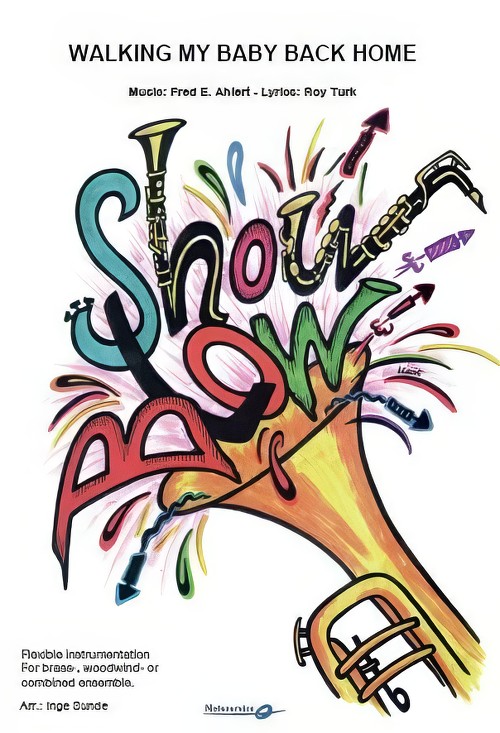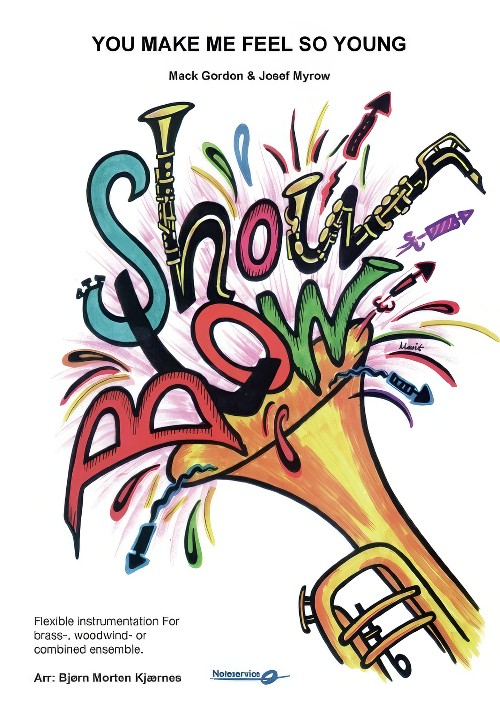Results
-
 £149.40
£149.40Feelings - Gaste
This song first became a hit by Brazilian singer Morris Albert. "Feelings" must be one of the most known love-songs of all time thanks to numerous recordings from artists like Ella Fitzgerald, Shirley Bassey, Nina Simone, Engelbert Humperdinck and Sarah Vaughan. The arrangement include parts that feature a soloist over a sectional accompaniment. Please watch the balance between soloist and band.
Estimated dispatch 7-14 working days
-
 £84.99
£84.99Lullaby of Birdland
Ive been arguably credited with having written some 300 songs, 299 of which enjoyed a rather bumpy ride from relative obscurity to total oblivion. Heres the other one. These are the words of the great Jazz pianist and composer George Shearing about his hit of the century Lullaby of Birdland. The list of famous artists who performed this Jazz standard runs from From Ella Fitzgerald to Amy Winehouse. Gilbert Tinner wrote this arrangement for Concert Band preserving the distinctive George Shearing Sound.
Estimated dispatch 7-14 working days
-
 £113.30
£113.30Moderate Dances - Angelo Sormani
This piece is a tribute to dance music, especially passionate, intense and meditative dance music. "Moderate Dances" is divided into three movements: a "Tango", a "Slow Waltz" and a "Bossa Nova". Each movement and each dance has its own particular characteristics but, when combined, these different rhythmic beats and times give the piece a feeling of completeness and uniformity. The Tango started to flourish in the suburbs of Buenos Aires in around 1880. There is still some doubt as to its origins, which may be Cuban (Habanera) but are probably African. It was most popular in Argentina and Brazil: here the male protagonist was originally the "gaucho" with his inseparable guitar, later to be replaced by the proud, elegant "compadre". By around 1910 the Tango had spread to Italy and France. New clubs opened, where the upper classes could watch and dance the Tango. Here the dance also underwent some rapid transformations. The exaggerated and extravagant gestures and body movements disappeared. Slow, gliding steps replaced the old rotational movements. The women's red ankle-boots and the partners "staring into each other's eyes" accentuated the erotic nature and sensuality of this dance. So much so that, in 1913, the German government banned soldiers from dancing the Tango. Those who broke the law were immediately discharged from the army. From a strictly musical perspective, the basic instruments were a flute, a harp (the diatonic harp typically played by the Indians of Paraguay) and a violin, or flute, guitar and violin or even clarinet, guitar and violin. These instruments were easy to transport, ideal for playing at parties, in the streets and in courtyards. The musicians played by ear, frequently improvising: there were no scores, no records, which is the main reason why it is impossible to trace the Tango back to its exact origins. However, the Tango's evolution (and growing popularity) was once again fostered by its fundamental ability to absorb "other" cultures, languages and sounds. And it was the arrival of the "bandoneon" (an accordion-like instrument that was invented in Germany and brought to Rio de la Plata by some immigrant), which replaced the flute, that marked the beginning of the Tango's huge success outside Argentina. A number of talented composers, above all the great Astor Piazzola (1921-1992), transformed the bandoneon from a simple accompanying instrument to a solo instrument that was to become the distinguishing feature of the 20th century Tango. The Slow Waltz originated from the Waltz, the typical dance of the Bavarian and Tyrolese peasants in the 1700s. It was composers like Johann Strauss, father and son, who carried the Waltz to its zenith in the 1800s, creating the sensual and melancholy yet joyful and charming dance we are all familiar with. When the Waltz first became popular in Germany, the members of respectable society were shocked at the closeness of the dancing partners, who had always previously danced apart. The main difference between the Waltz and Slow Waltz is that the latter has a slower, more expressive rhythm: the men wear tails and the women wear ball gowns decorated with beads and feathers and couples dance in graceful rotational movements. "Bossa Nova" is the title of the last movement in the piece. Jobim, the great Brazilian musician, described this musical genre as a combination of modern Jazz and Samba. Bossa Nova means "new wave". This was the name of the artistic and musical movement that evolved in Brazil in the late Fifties and was extremely popular throughout the Sixties. The songs are usually about love or social matters, drawing inspiration from the slums of Rio De Janeiro and the lives of their inhabitants. Bossa Nova, with its original compositions and the artistic talent of its musicians, also became hugely popular in the United States and Europe, and top Jazz musicians (Ella Fitzgerald, Stan Getz, Bob Cooper, Charlie Bird, Sonny Rollins, Dexter Gordon, Dizzy Gillespie) started to include Bossa in their repertoires.
Estimated dispatch 7-14 working days
-
 £76.99
£76.99Feelings - Morris Albert
Feelings is a well-known easy listening hit that was written halfway through the 1970s, by the Brazilian singer-songwriter Morris Albert. However, the melody is derived from a French song (Pour toi) from 1957, written by Louis Gaste, who made this claim successfully. Over the years, Feelings has been performed by famous artists like Ella Fitzgerald, Frank Sinatra and Elvis Presley. Numerous arrangements have been made for various instrumentations. This arrangement by Roland Kernen does justice to the original.
Estimated dispatch 7-14 working days
-
 £84.99
£84.99Sleigh Ride
This light-hearted, cheerful Christmas classic was written by the American composer Leroy Anderson. According to reports, he wrote this piece during a heat wave in July 1948. Mitchell Parish wrote the lyrics to the music in 1950. Since then many famous artists have recorded and performed this song, including the Carpenters, Ella Fitzgerald and Diana Ross. This Sleigh Ride arrangement by Stefan Schwalgin is close to the original and will be a great addition to any Christmas Concert.
Estimated dispatch 7-14 working days
-
 £137.99
£137.99Antonio Carlos Jobim Medley - Antonio Carlos Jobim
The Brazilian composer Antonio Carlos Jobim is considered to be thefounder of bossa nova - a supple, relaxed music style based on Brazilian samba rhythms. Jobim wrote many standards, which in the course of time have been performed by numerous famous artists, from Astrud Gilberto, Frank Sinatra and Ella Fitzgerald, to Sting and George Michael. His songs are still popular all over the world. Add a little Brazilian magic to your concert with this atmospheric medley which features six of Jobims well-known hits.
Estimated dispatch 7-14 working days
-
 £104.99
£104.99So In Love - Cole Porter
Cole Porter was one of the great masters of Broadway musicals during the thirties, forties and fifties, with So in Love, from the musical Kiss Me Kate, being one of his best loved works. It has been recorded by many artists including Bing Crosby, Lulu, Shirley Bassey and Julie Andrews, however it is the Ella Fitzgerald version that is best known. This jazzy musical classic can now be enjoyed by your brass band with this excellent new arrangement.
Estimated dispatch 7-14 working days
-
 £118.99
£118.99The African sound of Bert Kaempfert - Bert Kaempfert
The composer, arranger and band leader Bert Kaempfert is considered a giant in the field of easy listening music. He wrote songs for world renowned stars such as Ella Fitzgerald, Peggy Lee, Shirley Bassey, Anita Kerr, Frank Sinatra and many others. He created his own unique sound with the Bert Kaempfert Orchestra and had huge international success. His affinity with 'black music' is significant and his fascination with South African sounds led to their incorporation into several of his compositions and arrangements. Roland Kernen has used the following well-known tunes in this medley: Zambesi, African Beat, Wimoweh, Happy Trumpeter and Skokiaan.
Estimated dispatch 7-14 working days
-
 £66.95
£66.95Walking My Baby Back Home (Flexible Ensemble - Score and Parts) - Ahlert & Turk - Sunde, Inge
One of the most recent versions recorded of this is from 2008, with Natalie Cole singing a virtual duet with her father, Nat King Cole, who made the song a hit more than 50 years earlier, in 1952. The song was composed in 1930 by Roy Turk and Fred E. Ahlert, two famous songwriters in the big band, swing and jazz music of the time. The song was recorded by a large number of artists in the 30s, 40s and 50s, including Louis Armstrong, Bing Crosby, Ella Fitzgerald and Dean Martin.Flexible instrumentation (Flex 5 ShowBlow) makes it playable for small as well as larger ensembles.Duration: 2.45
Estimated dispatch 7-14 working days
-
 £51.50
£51.50You Make Me Feel So Young (Flexible Ensemble - Score and Parts) - Gordon & Myrow - Kjaernes, Bjorn Morten
You Make Me Feel So Young is a 1946 popular song composed by Josef Myrow (born in Tsarist, Russia), with lyrics written by Mack Gordon (born in Warsaw). It was introduced in the 1946 musical film Three Little Girls in Blue, where it was sung by the characters performed by Vera-Ellen and Charles Smith (with voices dubbed by Carol Stewart and Del Porter).The song was recorded by Frank Sinatra in 1956 and performed frequently throughout his career. His version is featured in the 2003 movie Elf. Many other artists, including Ella Fitzgerald, Helen Reddy, and Michael Buble, have covered the song.Flexible instrumentation (Flex 5 ShowBlow) makes it playable for small as well as larger ensembles.Duration: 3.15
Estimated dispatch 7-14 working days
